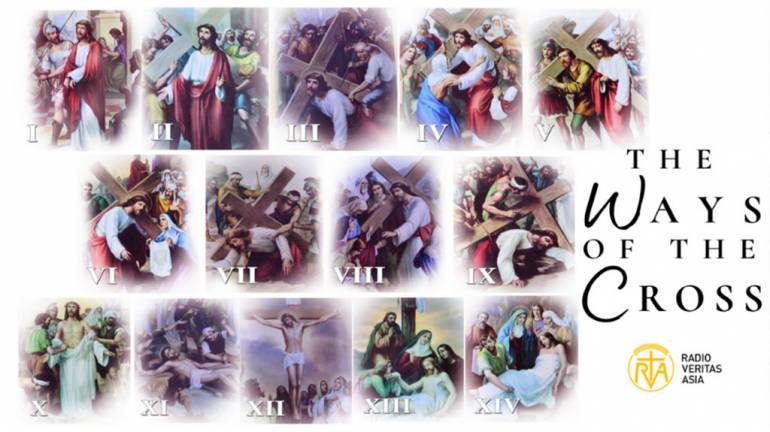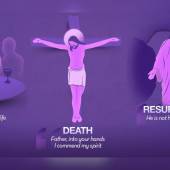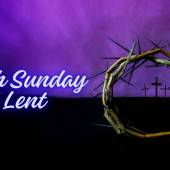Marking the station of the Cross by our lives

The ‘Stations of the Cross’ [SOTC] is one of Catholicism’s most identifiable Lenten traditions—a pious devotion that makes prayerful contemplation on the 14 steps that marked Christ’s final journey to Calvary in fulfilling his Father’s will.
Origins steeped in history
The origins of this profound practice per se, dwelling as it does on the Mystery of the Passion, Death, and Resurrection of Jesus, hark back to the pilgrimages the early Christians made to the various historical sites in Jerusalem associated with the said mystery.
The tradition which continued throughout the middle ages was further popularized by the Franciscans on becoming custodians of the historical sites in Jerusalem and the Holy Land in 1342, in time spreading to other parts of Western Europe.
The varying numbers and names of stations finally came to be consolidated in the set of fourteen recorded in Spain in the first half of the 17th century, especially in Franciscan communities. Spreading thence first to Sardinia (then under Spanish domain), it found in Italy a convinced apostle in Saint Leonard of Port Maurice (c 1751), a Franciscan friar who tirelessly went about erecting over 572 Via Crucis [Way of the Cross], including the famous one inside the Colosseum in December 1750 at the behest of Pope Benedict XIV. It is to this pope that the papal practice of annually leading the devotion on Good Friday in the Colosseum, which was revived in the 20th century by Pope Saint Paul VI, owes itself.
The SOTC, also known as the Via Dolorosa (literally, “Sorrowful Way”), has in recent times been concluding with a ‘fifteenth station’, viz the Resurrection, further adding to its significance. Geographically speaking, the Via Dolorosa is a street, in two parts, within the Old City of Jerusalem, considered the path that Jesus traversed to his crucifixion, bearing his cross, making the winding route from the Antonia Fortress west to the Church of the Holy Sepulchre (a distance of about 600 meters), a celebrated place of Christian pilgrimage.
The current route, established in the 18th century (replacing all earlier versions) is marked by nine ‘Stations’, with the remaining five stations within the Church of the Holy Sepulchre since as early as the 15th century.
The Real and the Presumptuous
The Stations in effect commemorate 14 happenings traditionally marking Christ’s mission journey commencing from Pilate’s judgment seat [the Praetorium - Jn 18:28b]. After a severe flogging and grotesque Tomfoolery involving mocking, spitting upon and thorn-crowning by the Roman soldiery Jesus is made to carry his cross through the streets up Golgotha, and there crucified between two thieves. While Matthew 27:32 records the invaluable assistance rendered to him by Simon of Cyrene, Veronica figures nowhere in the passion narratives.
One theory has it that Jesus ‘shroud’ was folded into a square frame and displayed above a church altar whereby only an apparent imprint of the face was visible. With viewers probably concluding that this was the True Image [vera (Latin)+eikon/icon (Greek)] of Jesus, a legend about a woman named ‘Veronica’ daring to use her veil to wipe Jesus’ pain-ridden face, with him returning the soothing act of kindness with his facial imprint on the veil, soon developed.
The Church has always taken pride in sustaining itself on both Scripture and Tradition. And so it is with the SOTC. The Stations essentially serve a role similar to the gospel passion narratives: connecting us with the early Church whose members looked forward with fond hope to Christ’s Second Coming in glory, they invite us to contemplate and draw strength from His Passion, Death, and Resurrection. Both, the stations have taken from Scriptural notations and those inferred by tradition, urge us to follow his path of love, self-sacrifice and service by reflecting on Christ’s example of total self-emptying. There is no mention of any fall of Jesus, or even of his encounter with his mother. Yet, even as presumptions, these deemed happenings are not without significance. And that is precisely the challenge of the Stations.
Medieval devotion
The SOTC, as we understand the term today, dates to the late Middle Ages when the likes of Saints Bernard of Clairvaux (1153), Francis d’Assisi (1226) and Bonaventure of Bagnoregio (1274), with their loving, contemplative devotion, prepared the ground on which the devout practice eventually developed.
Significantly, the traditional opening of each station, “We adore thee O Christ, and we bless thee! Because by thy Holy Cross thou hast redeemed the world!” has come from the very saint who gave us the now popular Christmas Crib – Francis d’Assisi!
To a spirit of compassionate devotion for the mystery of the Passion may be added the enthusiasm aroused by the Crusades launched to regain possession of the Holy Sepulchre, a new flourishing of pilgrimages from the XII century onwards, and, from 1233, the stable presence of the Franciscan Friars Minor in the holy places.
Around 1294, Dominican friar, Rinaldo de Monte Crucis, in his Liber peregrinations, spoke of how he went up to the Holy Sepulchre “per viam, per quam ascendit Christus, baiulans sibi crucem” (i.e. via the way Christ ascended with his cross), describing the different stations: Herod's Palace, the Lithostratos, where Jesus was condemned to death, the place where Jesus met the women of Jerusalem, the place where Simon of Cyrene shouldered the Lord's cross, and so forth.
In Rome, this spiritual journey of Jesus sets out anew annually on Good Friday, led by the Pope himself—who is Bishop of Rome—in union with Christians worldwide. This takes place in Rome’s Colosseum, the one venue that has ubiquitously become closely associated with Christian martyrdom and virtually the symbol of abiding faith – a symbol that, in the words of Pope Saint John Paul II, “speaks to us of times past, of that great Roman Empire that has collapsed. It speaks to us of those Christian martyrs who have given witness here with their life and their death. It is hard to find another place where the Mystery of the Cross speaks more eloquently than it speaks here” (April 18, 2003).
Deeper significance….
The Stations are a fusion of three different devotions that were said to be widespread since the early 15th century, especially in Germany and the Netherlands:
- A devotion to the times that Christ fell under the weight of the cross;
- A devotion to the “sorrowful way of Christ” that consisted at first in processions from one church to another (to as many as seven or nine) commemorating the sorrowful way—marking Jesus’ own “processions” during that fateful period: from Gethsemane to the house of Annas (Jn 18:13); from Annas’ residence to that of Caiaphas (Jn 18:24; Mt 26:56); the walk to Pilate’s Prætorium (Jn 18:28; Mt 27:2); the walk to Herod’s Palace (Lk 23:7).
A devotion to the “stations of Christ” i.e. those moments when Jesus stopped along the way to Calvary, for reasons of the heavy burden he was born, because of exhaustion, or moved by love and compassion, to exchange a word or two with individuals along the way participating in his passion, each of these halts coming to be marked with a pillar or across which, over the time, became objects of reverence.
The central aim of the Stations is not so much the re-enactment of past historical events but savouring the Lord’s reassuring presence amongst us and being inspired by his words and witness. When we pray the Stations under the influence of His own words, allowing ourselves to be inspired by his life-witness, hope springs anew in the heart! Indeed, the scourging and physical pain that Jesus endured was minor in comparison to the pain caused by the real burden he was born—the weight of our sins that he bore to Calvary where he paid the penalty for them all.
Esoteric variety
Two notable elements in the long formation process of the Way of the Cross [WOTC] are the fluctuation of the ‘First Station’ and the variety of Stations. About the earliest WOTC, historians record at least four episodes identified as the First Station, viz: Jesus takes leave of his Mother; The Washing of the Feet; The Agony in Gethsemane; The Condemnation of Jesus in the Praetorium.
Further, the subject of the stations also varied. In the vast diversity of the choice, number and order of stations still prevailing in the 15th century, some schemas of WOTC included stations such as the Capture of Jesus, Peter's Denial, Scourging at the Pillar, the Defamatory Accusations at the house of Caiaphas, Mockery of the White Robe at Herod's palace.
Accordingly, the Stations as we have them today provide ample scope for devotional adaptations that can be supplemented by dramatization and spontaneous reflections and poetry, apart from the inclusion of scripture readings, soulful music and reverent silence. Appropriate posters or PowerPoint presentations and judicious use of the shades of light and darkness can also be effective in fostering an evocative atmosphere. Whatever form is adopted, the ceremonial should speak for itself without requiring verbose commentaries and without overly sentimental expressiveness. The crucial point is to be still at each station, contemplate Christ’s suffering, death and resurrection, and unite one’s heart, mind and will with those of Jesus as represented in the moving scenes.
The fourteen listed moments highlight the tragic interplay of persons, the struggle between the light of truth and the darkness of falsehood, each station facilitating a spiritual pilgrimage to the principal scenes of Christ’s suffering and death. Many in the world suffer immensely, peoples and cultures, families and individuals bearing on their shoulders sorrows and burdens, each differing dramatically from the other. Thus, rather than the mere fact of carrying the cross, what gives fullness of meaning to the cross is carrying it behind Jesus, not in a journey of anguished solitude, hopeless wandering, or rebellion, but a journey sustained and nourished by his all-encompassing presence.
Essentially, the cross reveals the extent to which God will go out of love for us. Those who identify with Jesus’ Cross and the SOTC, agree to identify also with the unwillingness to destroy and crucify. Thus, the question is not who, but what killed Jesus, and what vicious cycles of violence continue to make him trace the sorrowful crucifixion path in his sisters and brothers in the human family.
Spirit-led way
The life of Jesus as a whole is a journey traced by the Spirit: at the beginning of Jesus’ mission he is led by the Spirit into the desert (cf Lk 4:1), there to be prepared by temptations galore for the divine fire that was to burn in his breast as enough fuel to propel him to complete His mission by unwaveringly heading towards Jerusalem and trudging up Calvary (cf Lk 12, 49-50).
The last stage of the journey is unspeakably hard and painful yet immeasurably significant as is well brought out by the evangelists—Jesus, Son-of-God and Son-of-man walked via Crucis out of love for the Father and humanity, every step drawing him closer to accomplishing the Father’s plan of salvation.
Every new suffering of Jesus was a seed of future joy for humanity, every jeer a premise of glory. And his every encounter along that suffering path with friends, enemies, the indifferent along the streets, its stones bathed in his sweat and sanctified by his blood, serves as a chance for one final lesson, one last look, one supreme offer of reconciliation and peace: the hour of universal forgiveness (cf Lk 23:34); the pierced Heart: the opening of an inextinguishable fountain of grace (cf Jn 19:34); the immolation of the true Paschal Lamb, of whom not one bone would be broken (cf Jn 19:36); the gift of His Mother (cf Jn 19:26-27) and of the Spirit (cf Mt 27:50).
The Church, for her part, knows fully well that in everything that happened on the WOTC lies hidden a mystery of grace, a sign of his love for her. She is well aware that in the Eucharist her Lord left her the objective, sacramental memory of the body broken and the blood, shed atop Golgotha.
The aftermath...
As Holy Week approaches and Christians contemplate this holiest of seasons, we are reminded what a precious gift our salvation is and its price paid by Jesus: “But he was pierced for our transgressions, he was crushed for our iniquities; the punishment that brought us peace was upon him, and by his wounds, we are healed” (Isa 53:5). As we think about the pain and humiliation he suffered for us, paying a ransom that we could never pay ourselves, we can’t help but praise and thank him and commit ourselves to a life of obedience in him.
Contemplating the Stations, we, Jesus’ followers, must declare once more our discipleship: weeping like Peter for sins committed (Mt 27:75); opening our hearts to faith in Jesus the suffering Messiah, like the Good Thief (Lk 23:42); perhaps even repenting like Judas (Mt 27:3-5); or even remaining there at the foot of the Cross of Christ-like the Mother and the Disciple (Jn 19:26), and there with them receiving the Word that redeems, the Blood that purifies and the Spirit that gives life.
Radio Veritas Asia (RVA), a media platform of the Catholic Church, aims to share Christ. RVA started in 1969 as a continental Catholic radio station to serve Asian countries in their respective local language, thus earning the tag “the Voice of Asian Christianity.” Responding to the emerging context, RVA embraced media platforms to connect with the global Asian audience via its 21 language websites and various social media platforms.














